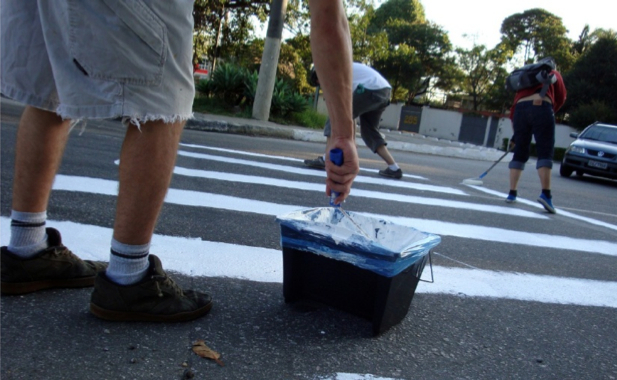Blog Post
Urbanist Manifesto: Grab Your Spray Paint, 'Cause City Planning's Going DIY
From guerilla gardening to commando crosswalk painting, a new breed of urbanists is using illicit means to create livable communities.

It's 3 a.m., and the city street is finally quiet. In the shadows under a defunct streetlight, three twenty-somethings in black hoodies pull cans of paint from a backpack and set furtively to work. When distant headlights sweep into view, they grab their gear with whispered profanities and duck into a nearby alley, returning when the sound of tires fades. Finishing shortly after, they pack up their gear and hurry off, triumphant at not getting caught. Soon the morning light reveals their illicit work: a bright new crosswalk.
When petitions don't work
This is the sort of guerrilla approach to urban repair discussed in the second volume of "Tactical Urbanism: Short-Term Action, Long-Term Change," just released by the Street Plans Collaborative and NextGen (The Next Generation of New Urbanists). Two dozen case studies from across North America illustrate the "growing number of short-term, often self-funded efforts" to improve streets and public areas, and ways in which they lead to permanent change.
These projects take the indignation and adrenaline rush of adbusting and billboard liberation and apply them to every corner of urban life where infrastructure needs improvement. Tired of petitioning the city for a community garden? Grab a few friends, picks, and shovels, and rip up the pavement in that abandoned lot yourself.
Grassroots feasibility testing
Mike Lydon, the author of "Tactical Urbanism," attributes the rise of these initiatives to three trends: the Great Recession's effects on city budgets; shifting demographics as young people move into "once forlorn walkable neighborhoods;" and access to the Internet as a means of sharing successful tactics and how-to manuals.
While the projects are usually unsanctioned at first, they demonstrate a community's desire for a given improvement (such as crosswalks or bike lanes) and provide an affordable means of proving its viability to city planners. When planners pay attention to these grassroots efforts rather than treating them as vandalism, they gain insight as to what changes to the built environment are necessary to improve residents' everyday lives and make a neighborhood more resilient.
From parking to parks
Many tactics involve combating the bias for vehicles built in to city infrastructure.
SUPPORT INDEPENDENT SUSTAINABILITY REPORTING
BuildingGreen relies on our premium members, not on advertisers. Help make our work possible.
See membership options »During the annual Park(ing) Day, individuals or groups adopt on-street parking spots to create public recreational spaces, often bringing plants to create temporary green spaces for people to refresh themselves and take a breather from the purely built environment. A New York City group called DoTank (as opposed to "think tank," highlighting the tactical urbanists' preference for immediate action over endless planning) improves the lot of urban pedestrians by chair bombing--building chairs from waste wood and distributing them in public places.
Do you or your friends routinely find yourselves complaining of a lack of bicycle parking in a given area? Handy activists can take it upon themselves to install bike racks where needed. Tactical urbanism can also be a cheap means of testing traffic-calming measures. Usually tested by transportation departments using traffic cones, this can be done by stealthy activists with sawhorses and orange spray-paint.
Pre-vitalization before revitalization
Another tactic highlighted is "site pre-vitalization," the temporary use of an inactive plot to generate revenue for the owner until more permanent development is possible. While ultimately controlled by the landowner, the details of pre-vitalization can be steered by the community and might include art exhibits, food markets, and festivals. Compare this approach to the ugly, faceless blight architects call "groundcover," according to Dolores Hayden in A Field Guide to Sprawl: "Inexpensive, easily bulldozed buildings such as self-storage units, constructed to generate income while a developer holds land."
This conventional approach capitalizes only on individual consumers' desire to protect their possessions and does nothing to create a sense of community.
Try a front-yard barbecue
To activate underused land at the scale of the individual, the tactic of "setback reclamation" tackles the awkward distance mandated between homes and sidewalks, which for so long has shifted social activity to the back yard and out of public view.
Reclamations highlighted in "Tactical Urbanism" include a community vegetable garden and the installation of a box of free poetry for passers-by.
The comedy of the commons?
Increasingly, says Lydon, municipalities are "permanently implementing the short-term, low-budget livability improvements initiated by citizen-activists." Activists should take heart at the historical example of the Parisian bouquinistes who set up informal bookshops along the Seine in the 1500s: first banned by the city, then grudgingly allowed, today the area in which the bouquinistes operate is a UNESCO World Heritage Site.
More recently, the Depave program in Portland, Oregon, began as an unsanctioned movement for "the removal of unnecessary pavement from urban areas" and is now funded by the City of Portland and the U.S. Environmental Protection Agency.
Often the need for a given improvement seems small in the perspective of city planners, who have too much on their plates to concentrate on one neighborhood or block, but is significant for people living in the affected area. "Tactical Urbanism" provides inspiration for us to take matters into our own hands.
Read the whole report at www.streetplans.org.
Published March 28, 2012 Permalink Citation
(2012, March 28). Urbanist Manifesto: Grab Your Spray Paint, 'Cause City Planning's Going DIY. Retrieved from https://www.buildinggreen.com/blog/urbanist-manifesto-grab-your-spray-paint-cause-city-plannings-going-diy



Add new comment
To post a comment, you need to register for a BuildingGreen Basic membership (free) or login to your existing profile.